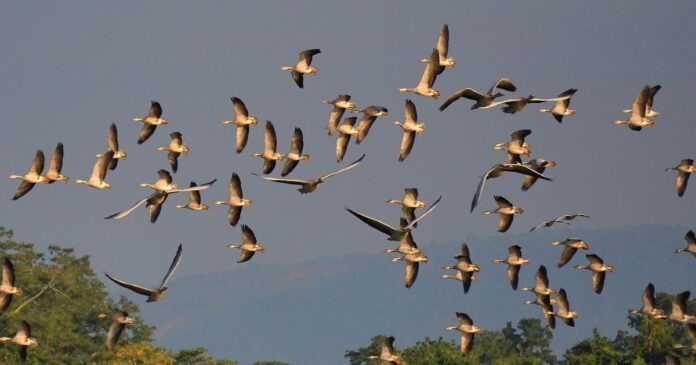In a significant ecological revelation, Kaziranga has emerged as the second-largest sanctuary for migratory birds in India. The renowned national park, celebrated for its thriving population of one-horned rhinoceros, now stands as a haven for a diverse array of migratory avian species.
The recent avifauna census conducted in Kaziranga has revealed a remarkable influx of migratory birds, establishing the park’s position as the second-most-preferred destination for these winged visitors. The park’s rich biodiversity, including its wetlands and grasslands, provides an ideal habitat for migratory birds seeking refuge during their seasonal journeys.
This newfound recognition for Kaziranga is not just a testament to the park’s natural beauty but also highlights its importance in preserving the delicate balance of ecosystems. The diverse landscapes within Kaziranga cater to the varied needs of migratory birds, offering them a safe haven for feeding, breeding, and resting.
The migratory bird population in Kaziranga includes several species that travel great distances, often traversing international borders. The wetlands within the park serve as crucial stopover points for these birds, allowing them to replenish their energy reserves before continuing their arduous journeys.
Conservation efforts within Kaziranga, focused on maintaining the ecological integrity of the park, have played a pivotal role in attracting migratory birds. The preservation of wetlands and the overall habitat management carried out by park authorities have created a conducive environment for these birds, solidifying Kaziranga’s status as a crucial migratory hotspot.
The recognition of Kaziranga as the second-largest home for migratory birds underscores the need for continued conservation efforts and heightened awareness about the significance of such ecosystems. The park’s role in supporting migratory bird populations goes beyond regional importance, contributing to the global conservation of avian biodiversity.
As visitors and nature enthusiasts flock to Kaziranga to witness the iconic one-horned rhinoceros, the revelation of its importance as a sanctuary for migratory birds adds a new layer of ecological significance to the park. This dual role as a haven for both terrestrial and avian species highlights Kaziranga’s status as a key player in the conservation landscape.
The emergence of Kaziranga as the second-largest home for migratory birds in India is a testament to the park’s ecological richness and conservation efforts. As the avian population finds solace in the park’s diverse landscapes, Kaziranga stands as a shining example of how careful preservation can transform a region into a sanctuary that caters to the needs of both resident and migratory species alike.




